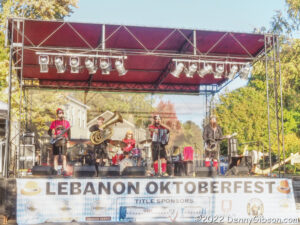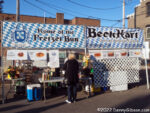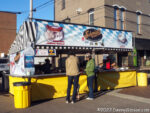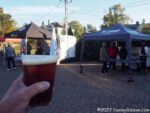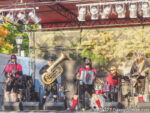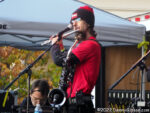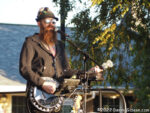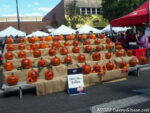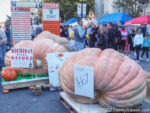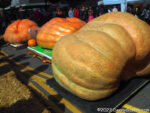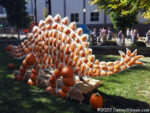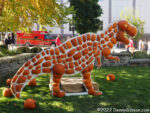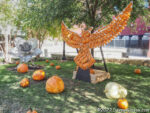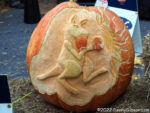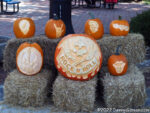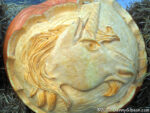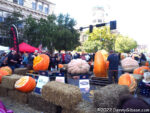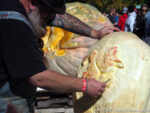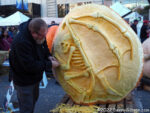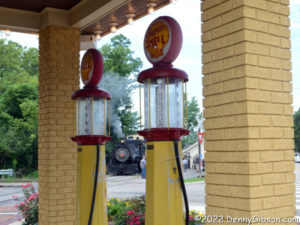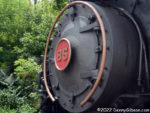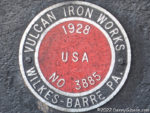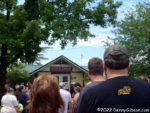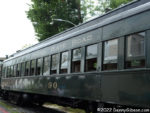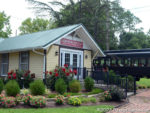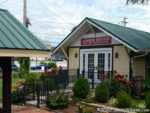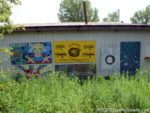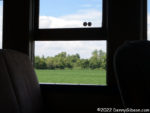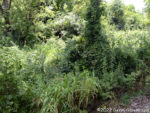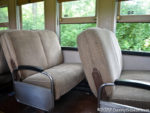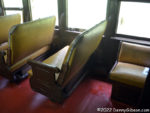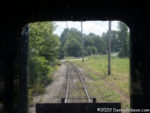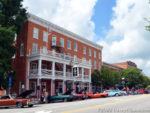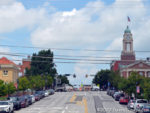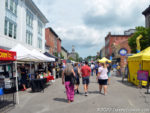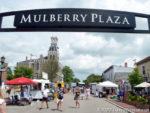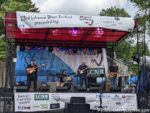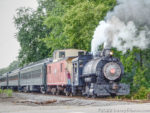Last night I completed the trifecta of southwest Ohio horse parades. I just happened to be in Greenville on the occasion of their parade two weeks ago. I blogged about it here. Last week I was again in Greenville and came home through Springfield with a goal of getting some pictures of the recently relocated Madonna of the Trail statue. (More on that later.) I was surprised to see downtown Springfield blocked off and more surprised to learn that it was for the city’s first ever horse parade. I certainly had to stick around for that.
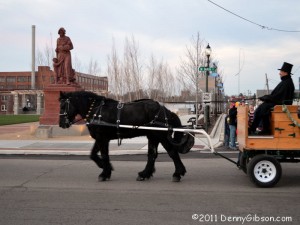 Carriage rides were available before the parade and, yes, I took one. Neither the carriage rides nor the parade actually passed the Madonna. The picture at right shows one of the “public” carriages leaving the blocked off area in anticipation of the parade itself. The parade formed behind where I stood to take the picture and turned right to reach the parade route proper.
Carriage rides were available before the parade and, yes, I took one. Neither the carriage rides nor the parade actually passed the Madonna. The picture at right shows one of the “public” carriages leaving the blocked off area in anticipation of the parade itself. The parade formed behind where I stood to take the picture and turned right to reach the parade route proper.
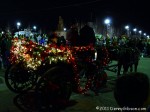
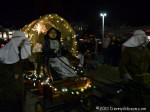 As mentioned, this was Springfield’s first year for a parade and there were just fourteen entries. All were “hitches”. In other words, there were no horseback riders. The portrayal of the Christmas story in a setting where eighteenth and and nineteenth century covered wagons (albeit with pneumatic rubber tires) was the norm was simultaneously shocking and 100% fitting. I liked it. Future generations of Springfieldians may have a very unique take on the whole Christmas-pioneer-Madonna-covered-wagon thing.
As mentioned, this was Springfield’s first year for a parade and there were just fourteen entries. All were “hitches”. In other words, there were no horseback riders. The portrayal of the Christmas story in a setting where eighteenth and and nineteenth century covered wagons (albeit with pneumatic rubber tires) was the norm was simultaneously shocking and 100% fitting. I liked it. Future generations of Springfieldians may have a very unique take on the whole Christmas-pioneer-Madonna-covered-wagon thing.
 So, after attending Springfield’s first and Greenville’s eighth more or less by accident, I felt almost obligated to attend Lebanon’s twenty-third horse parade. It’s not only the oldest of the three but, with 122 entries, far and away the biggest. It’s also the only double header. There is a daylight version at 1:00 and an in-the-dark illuminated-carriage version at 7:00. Other commitments kept me away from Lebanon until something after 1:00 but I headed there anyway thinking I might catch the tail end of the matinee. I couldn’t even get close. I whiled away the afternoon on the far side of town then returned thinking it entirely possible that I would just pass through again and head home. But I found a parking spot about three blocks from the Golden Lamb. In the Lamb’s Black Horse Tavern, I ran into some friends I hadn’t seen in quite awhile and managed to while away another couple of hours until parade time was near.
So, after attending Springfield’s first and Greenville’s eighth more or less by accident, I felt almost obligated to attend Lebanon’s twenty-third horse parade. It’s not only the oldest of the three but, with 122 entries, far and away the biggest. It’s also the only double header. There is a daylight version at 1:00 and an in-the-dark illuminated-carriage version at 7:00. Other commitments kept me away from Lebanon until something after 1:00 but I headed there anyway thinking I might catch the tail end of the matinee. I couldn’t even get close. I whiled away the afternoon on the far side of town then returned thinking it entirely possible that I would just pass through again and head home. But I found a parking spot about three blocks from the Golden Lamb. In the Lamb’s Black Horse Tavern, I ran into some friends I hadn’t seen in quite awhile and managed to while away another couple of hours until parade time was near.
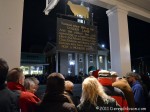
 I’ve attended both light and dark versions of the Lebanon parade before but it’s been a long time. Both the parade and attendance have had time to grow and they certainly have. All of downtown Lebanon was pretty much shoulder to shoulder and withers to withers.
I’ve attended both light and dark versions of the Lebanon parade before but it’s been a long time. Both the parade and attendance have had time to grow and they certainly have. All of downtown Lebanon was pretty much shoulder to shoulder and withers to withers.
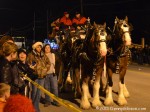
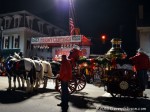 Several of the parade participants had been at Greenville and a few had been at Springfield but with more than eight times Springfied’s entries and nearly double Greenville’s, Lebanon obviously had some exclusives. Foremost among these were a nineteenth century fire engine and a team of Clydesdales. Both of these actually brought cheers from the crowd when they charged down the street.
Several of the parade participants had been at Greenville and a few had been at Springfield but with more than eight times Springfied’s entries and nearly double Greenville’s, Lebanon obviously had some exclusives. Foremost among these were a nineteenth century fire engine and a team of Clydesdales. Both of these actually brought cheers from the crowd when they charged down the street.
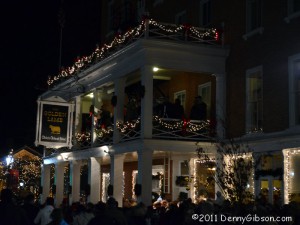 During the parade I managed to somehow walk to it’s origin and back. Some of it was pretty awkward but in the end I just stepped into the street and paced the parade. I recall my father once telling me that the secret to getting around a military base is to carry a clipboard and walk briskly. The same technique works with parades using a camera. The friends I had met in the bar told of past success in watching the parade from the balcony at the Golden Lamb. Even though that appeared to be a bit more challenging than in prior years, they were going to give it a try. As the parade wrapped up, I snapped this picture of the hotel’s balcony just in case they were up there. No, I later learned, they had been blocked from the balcony but found an empty third floor dining room where they and another couple watched the parade in relative privacy. The only intruder was a hotel employee who stopped by now and then to take drink orders.
During the parade I managed to somehow walk to it’s origin and back. Some of it was pretty awkward but in the end I just stepped into the street and paced the parade. I recall my father once telling me that the secret to getting around a military base is to carry a clipboard and walk briskly. The same technique works with parades using a camera. The friends I had met in the bar told of past success in watching the parade from the balcony at the Golden Lamb. Even though that appeared to be a bit more challenging than in prior years, they were going to give it a try. As the parade wrapped up, I snapped this picture of the hotel’s balcony just in case they were up there. No, I later learned, they had been blocked from the balcony but found an empty third floor dining room where they and another couple watched the parade in relative privacy. The only intruder was a hotel employee who stopped by now and then to take drink orders.
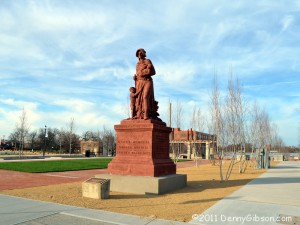 Now, about that Madonna. In 1928 and ’29, as the era of named auto trails came to an end, the Daughters of the American Revolution placed a Madonna of the Trail statue in each of the twelve states through which the National Old Trails Road passed. The one for Ohio was placed in Springfield. Two of the four sides on each statue’s base were inscribed with information specific to the statue and its placement. On Ohio’s Madonna these concerned the end of federally funded construction, which was quite close to the statue’s original placement, and George Rogers Clark victory at Peckuwe which was about three miles from the original placement as noted in the inscription. In the mid 1950s, highway construction caused the statue to be moved about a half mile east. The inscriptions were no longer as accurate as they had been but they weren’t off too much. A bigger problem with the move was that, once US-40 became four lanes wide, there was no convenient access to the statue. Reaching it involved either pulling over on the busy highway or parking in a safe spot and walking along the busy highway.
Now, about that Madonna. In 1928 and ’29, as the era of named auto trails came to an end, the Daughters of the American Revolution placed a Madonna of the Trail statue in each of the twelve states through which the National Old Trails Road passed. The one for Ohio was placed in Springfield. Two of the four sides on each statue’s base were inscribed with information specific to the statue and its placement. On Ohio’s Madonna these concerned the end of federally funded construction, which was quite close to the statue’s original placement, and George Rogers Clark victory at Peckuwe which was about three miles from the original placement as noted in the inscription. In the mid 1950s, highway construction caused the statue to be moved about a half mile east. The inscriptions were no longer as accurate as they had been but they weren’t off too much. A bigger problem with the move was that, once US-40 became four lanes wide, there was no convenient access to the statue. Reaching it involved either pulling over on the busy highway or parking in a safe spot and walking along the busy highway.
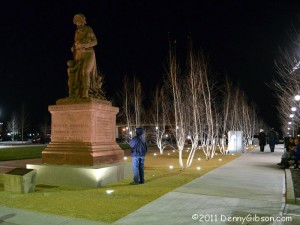 In September, the statue was again moved. This move was about two miles distance to a park in downtown Springfield. The setting makes the statue much more accessible while making the inscriptions much less accurate. Some consider this a net win; Others don’t. During the hour or so I hung around the statue last Saturday, I saw about twenty people take note of the statue in some way. There was a lot of foot traffic in the area Saturday and the majority seemed oblivious to both the new park and the relocated statue. Of those that noticed it, about half recognized it including one fellow who arrived with camera and tripod to photograph the old gal in her new home. Quite a few of those who had no idea what it was did read at least one panel. Several read them all. Whether or not any of them develop even the slightest interest in any aspect of the history that this Madonna of the Trail represents is anybody’s guess.
In September, the statue was again moved. This move was about two miles distance to a park in downtown Springfield. The setting makes the statue much more accessible while making the inscriptions much less accurate. Some consider this a net win; Others don’t. During the hour or so I hung around the statue last Saturday, I saw about twenty people take note of the statue in some way. There was a lot of foot traffic in the area Saturday and the majority seemed oblivious to both the new park and the relocated statue. Of those that noticed it, about half recognized it including one fellow who arrived with camera and tripod to photograph the old gal in her new home. Quite a few of those who had no idea what it was did read at least one panel. Several read them all. Whether or not any of them develop even the slightest interest in any aspect of the history that this Madonna of the Trail represents is anybody’s guess.
A newspaper article about the September 22 move is here. The Madonna can be seen thirteen days before the move here and here.
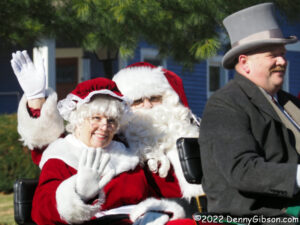 In the very first year of this blog, I attended a triple header of holiday horse parades and documented them in two posts. I wrote about a nighttime parade in Greenville here and nighttime parades in Springfield and Lebanon here. There was a fourth parade that I mentioned but did not get to see in 2011. The parade in Springfield was their first and I don’t believe it lasted much beyond that inaugural year. Greenville’s 10th annual Hometown Holiday Horse Parade took place a couple of weeks ago. The nighttime 33rd annual Lebanon Horse Drawn Carriage Parade took place last night and the daytime version, which is the parade I missed in 2011, took place yesterday afternoon. This time I made it.
In the very first year of this blog, I attended a triple header of holiday horse parades and documented them in two posts. I wrote about a nighttime parade in Greenville here and nighttime parades in Springfield and Lebanon here. There was a fourth parade that I mentioned but did not get to see in 2011. The parade in Springfield was their first and I don’t believe it lasted much beyond that inaugural year. Greenville’s 10th annual Hometown Holiday Horse Parade took place a couple of weeks ago. The nighttime 33rd annual Lebanon Horse Drawn Carriage Parade took place last night and the daytime version, which is the parade I missed in 2011, took place yesterday afternoon. This time I made it.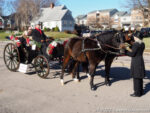
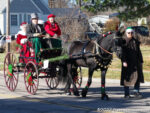 Lebanon’s nighttime parade typically has well over 100 entries. The daytime parade is a bit smaller. The highest numbered unit I saw was 80 and there were a few gaps in the numbering. The pictures at left are of carriages carrying the parade’s Grand Marshal and the couple seen waving in the opening photo. The Grand Marshal was not identified on the carriage, I’ve found nothing online, and I didn’t recognize him. Maybe you can.
Lebanon’s nighttime parade typically has well over 100 entries. The daytime parade is a bit smaller. The highest numbered unit I saw was 80 and there were a few gaps in the numbering. The pictures at left are of carriages carrying the parade’s Grand Marshal and the couple seen waving in the opening photo. The Grand Marshal was not identified on the carriage, I’ve found nothing online, and I didn’t recognize him. Maybe you can.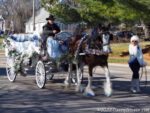

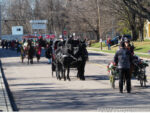 Some elegant horses followed including a pair sporting glittery blue hooves.
Some elegant horses followed including a pair sporting glittery blue hooves.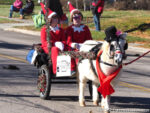
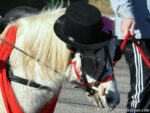 The number of small ponies in the parade kind of surprised me. I felt a little sorry for some of the tiny creatures pulling Santa Claus-sized individuals. I also felt a little sorry for some passengers who, although they looked quite cute, didn’t seem overly happy with the hats they were made to wear. The pony may deserve some pity, too.
The number of small ponies in the parade kind of surprised me. I felt a little sorry for some of the tiny creatures pulling Santa Claus-sized individuals. I also felt a little sorry for some passengers who, although they looked quite cute, didn’t seem overly happy with the hats they were made to wear. The pony may deserve some pity, too.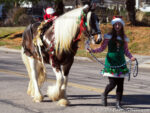
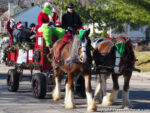 Even though I know that the Grinch’s heart “grew three sizes that day”, I am still a little surprised every time I see him as a symbol; of Christmas. Given the parade’s name, I was also surprised to see one of those new-fangled carriageless horses.
Even though I know that the Grinch’s heart “grew three sizes that day”, I am still a little surprised every time I see him as a symbol; of Christmas. Given the parade’s name, I was also surprised to see one of those new-fangled carriageless horses.

 There was certainly no lack of power near the parade’s end where a couple of six-horse teams appeared. Secure in the safety of both size and number, a member of one of those teams had no qualms about openly laughing at me as my cold hands tried to focus the camera on his face.
There was certainly no lack of power near the parade’s end where a couple of six-horse teams appeared. Secure in the safety of both size and number, a member of one of those teams had no qualms about openly laughing at me as my cold hands tried to focus the camera on his face. 
